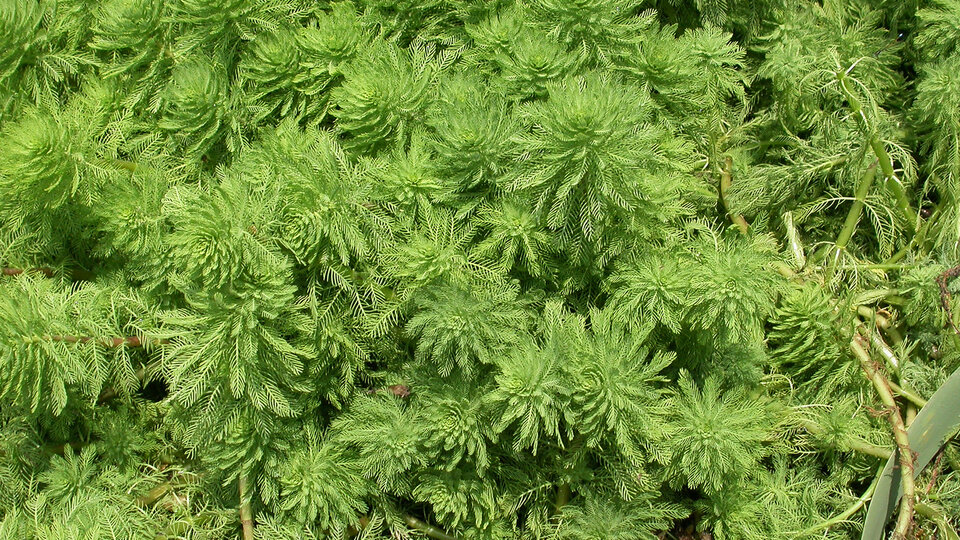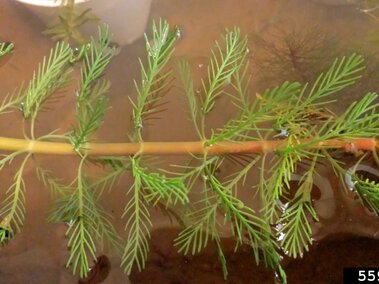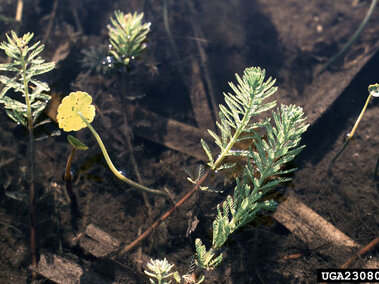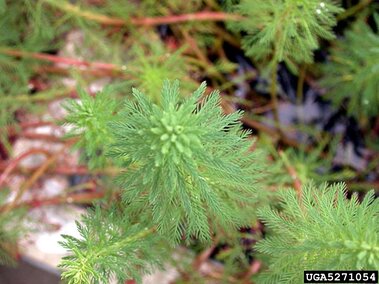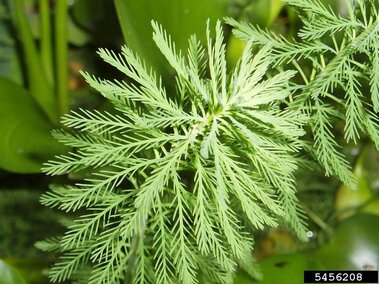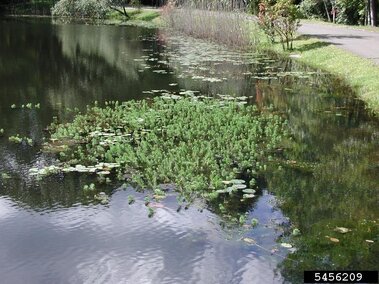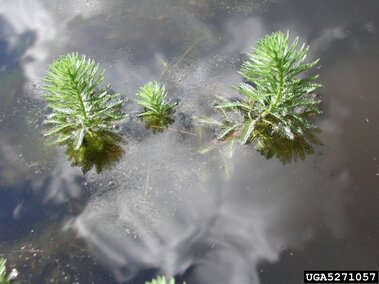General Information
Species Name: Myriophyllum aquaticum
Also Known As: Brazilian watermilfoil, parrotfeather, parrot feather, parrot-feather, parrot's feather, parrot feather watermilfoil, red-stemmed parrot feather
Family: Haloragaceae (Water Milfoil)
Growth Form: Forb (submersed aquatic)
Life Span: Perennial
Flowering Dates: May-July
Origin: South America
Noxious: No
Category 1: Potential Aquatic Invasive Species
Why Is It Invasive?
Parrot feather forms monocultures that clog waterways, impeding recreational and commercial boating activities. These monocultures also disrupt the growth of native aquatic plants and provide breeding areas for mosquitoes. It is a common water garden plant, which has the potential to escape into local waterways. Control of this plant is extremely costly.
What Does It Look Like?
General Characteristics
Parrot feather is an herbaceous, rooted, submerged to emergent plant that invades aquatic habitats throughout much of the United States.
Flowers
Small, white flowers occur in the leaf axils on the emergent shoots and are approximately 1/16 inch long.
Leaves
Leaves are abundant, whorled, pinnately compound, and finely dissected. Submersed leaves are 0.6-1.4 in. (1.5-3.5 cm) long and have 20 to 30 divisions per leaf. Submersed leaves are reddish orange. When the submersed shoots reach the water surface, plant growth changes and begins to creep along the water surface with extensive branching from nodes followed by vertical growth of emergent stems. Emergent leaves are 0.8-2 in. (2-5 cm) long, appear feather-like and grayish green, and can extend to 30 cm above the water surface.
Stems
Stems are stout, blue-green in color, and can grow up to 5 feet.
Seeds
Parrot feather is a dioecious species, however only pistillate (female) plants are found outside of South America. Staminate (male) plants are rare even in native populations of South America. For this reason, seed production is not known to occur and reproduction is exclusively vegetative in North America. Reproduction occurs by fragmentation of emergent and/or submersed shoots, roots, rhizomes, or attached plant fragments.
Photos
Where Does It Grow?
Parrot feather occurs in slow-moving fresh water habitats such as tributaries, canals, ponds, and lakes. It shows preference for high nutrient environments with plenty of light. In the USA it is found in coastal and southern states invading shallow lakes, ponds, ditches and backwaters in rivers forming dense mats. The plant grows best in an environment where light can penetrate to the bottom but can occur as a floating plant in the deep waters of nutrient rich lakes.
How Does It Spread?
It was first introduced in the United States due to its attractiveness as an aquarium or water garden plant. Parrot feather has escaped cultivation and has spread into water bodies through intentional plantings and growth of plant fragments. The brittle nature of stems results in many fragments that root easily in moist soils to establish new colonies. Plant fragments with their robust leaves and stems, and thick waxy cuticle, can survive periods out of water. Fragments can spread by currents, water fowl, and by boats. In the United States it has spread to 26 states including Hawaii, as far north as New York, west to Washington State, and all southern states but widely distributed in Alabama, Arizona, Louisiana, Mississippi and Tennessee.
How Do I Control It?
Management of invasive aquatic plants involving either mechanical removal of plants or application of herbicides to public waters requires a permit. Contact the Contact the Nebraska Game and Parks Commission for more information.
Mechanical
Cutting or pulling the plant by hand or with equipment such as rakes or cutting blades could break it into fragments, allowing it to further spread. Contact the Nebraska Game and Parks Commission to determine appropriate removal methods.
Cultural
CLEAN your watercraft, trailer, angling gear and other equipment. Remove all aquatic vegetation and animal species from your equipment.
DRAIN your watercraft at the ramp by removing the boat plug and draining all live wells and ballast tanks.
DRY your watercraft, trailer and other equipment for at least 7 days before visiting another waterbody.
DON'T LET IT LOOSE. Do not release or transport exotic or non-native fish species to new ecosystems, and do not dump aquariums. It is unlawful to release any aquatic species into a waterbody other than the one from which it was harvested. Doing so can promote the spread of AIS.
Chemical
Application of chemicals to public waters requires a permit. Contact the Contact the Nebraska Game and Parks Commission for more information.
What Should I Do If I See It in Nebraska?
If you see parrot feather in Nebraska, you should report it to the Nebraska Game and Parks Commission's Aquatic Invasive Species (AIS) Program using their AIS Report Form. For guidance on what information to include in your report, check out our reporting tips.
References and More Information
Center for Invasive Species and Ecosystem Health
Nebraska Game and Parks Commission
North Carolina State Extension Gardener Plant Toolbox
Rutgers University New Jersey Agricultural Experiment Station
Tualatin Soil and Water Conservation District
U.S. Fish and Wildlife Service Ecological Risk Screening Summary
